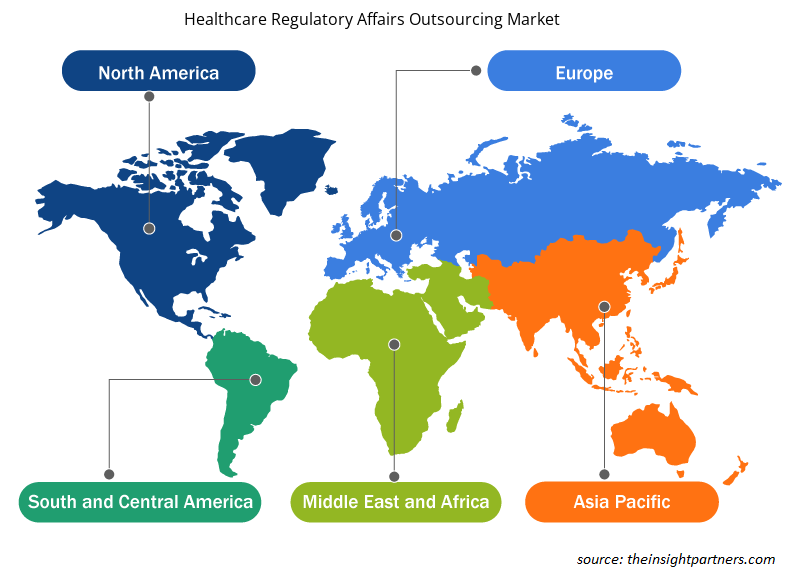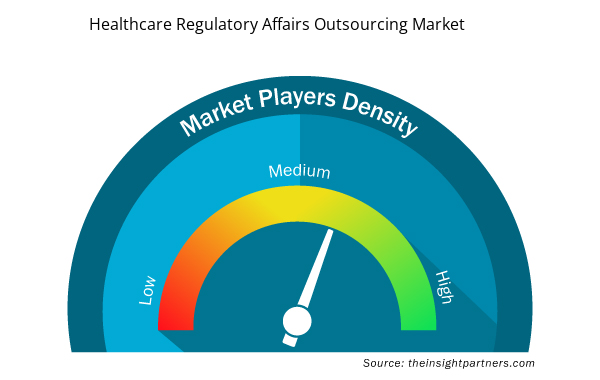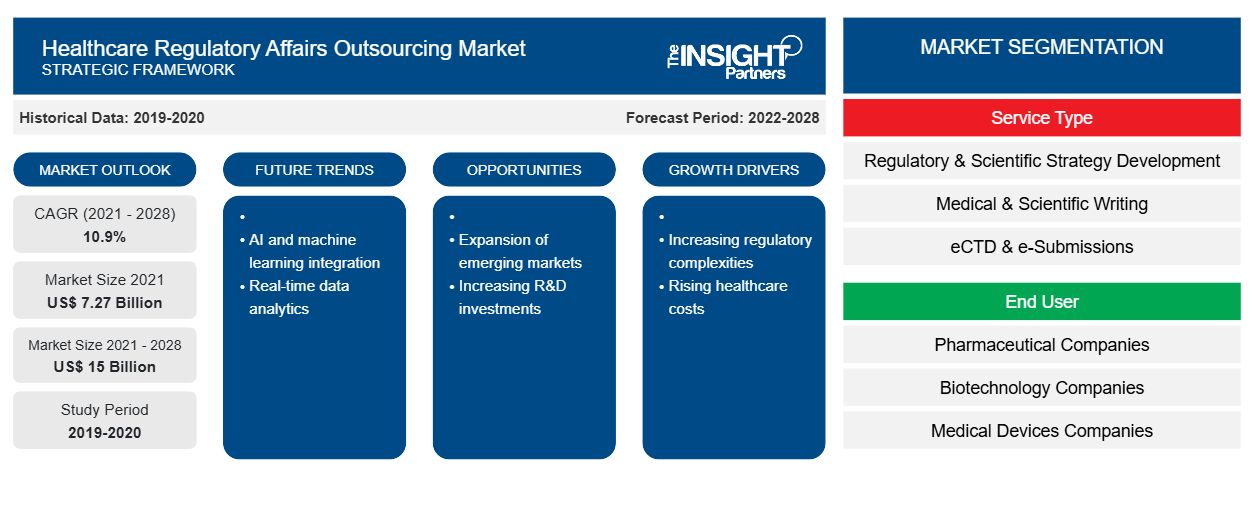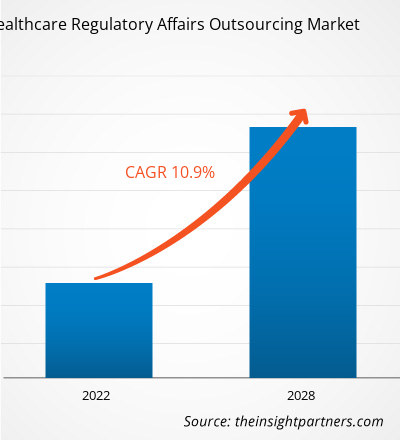[Rapporto di ricerca] Si prevede che il mercato dell'outsourcing degli affari normativi in ambito sanitario raggiungerà i 14.996,35 milioni di dollari entro il 2028, rispetto ai 7.274,73 milioni di dollari del 2021; si prevede che crescerà a un CAGR del 10,9% dal 2021 al 2028.
La crescente pressione normativa sulle aziende sanitarie e la crescente domanda di approvazione rapida di nuovi prodotti. Tuttavia, la carenza di professionisti qualificati sta frenando la crescita del mercato dell'outsourcing degli affari normativi sanitari . L'outsourcing degli affari normativi è il servizio offerto alle industrie farmaceutiche, biotecnologiche e di produzione di dispositivi medici. I servizi di outsourcing degli affari normativi aiutano a ottenere approvazioni normative rapide. Le industrie di outsourcing degli affari normativi stanno aiutando a ottenere l'approvazione per nuovi prodotti, preparando protocolli per condurre una sperimentazione clinica, pubblicando relazioni ecc. Un aumento della domanda di vari servizi come consulenza normativa, redazione medica e pubblicazione della documentazione normativa, domande di sperimentazione clinica e consulenza normativa e rappresentanze legali, domanda di brevetto, registrazione del prodotto e domande di sperimentazione clinica ha portato a un'impennata nell'adozione di attività di outsourcing degli affari normativi sanitari.
Personalizza questo report in base alle tue esigenze
Riceverai la personalizzazione gratuita di qualsiasi report, comprese parti di questo report, o analisi a livello nazionale, pacchetto dati Excel, oltre a usufruire di grandi offerte e sconti per start-up e università
- Scopri le principali tendenze di mercato in questo rapporto.Questo campione GRATUITO includerà analisi di dati che spaziano dalle tendenze di mercato alle stime e alle previsioni.
Approfondimenti di mercato
Aumento della pressione normativa sulle aziende sanitarie Crescita del mercato dell'outsourcing degli affari normativi sanitari
I continui aggiornamenti e progressi negli approcci tradizionali allo sviluppo dei farmaci stanno creando sfide significative nel settore sanitario. C'è un'enorme pressione sulle aziende farmaceutiche e sulla comunità medica per ridurre il costo dei farmaci da prescrizione, mentre i loro costi operativi stanno salendo alle stelle. La complessità dei requisiti normativi, il calo dei ricavi dovuto alla scadenza del brevetto dei farmaci di successo e la pressione da parte dei governi e delle assicurazioni sanitarie per la riduzione dei costi sanitari hanno presentato ulteriori sfide ai settori sanitari. Date queste difficoltà, le aziende farmaceutiche hanno capito la necessità di sfruttare le proprie risorse insieme alle competenze fornite da fonti esterne specializzate. Molte società di consulenza normativa di fascia alta offrono la propria competenza per l'intero ciclo di vita del prodotto. L'outsourcing degli affari normativi può consentire agli sponsor di acquisire esperienza, ottimizzare i costi e migliorare la produttività. Le società di outsourcing normativo sono in una posizione migliore per valutare i requisiti normativi, il che consente loro di selezionare le migliori soluzioni. Sono esperte nella comprensione associata all'implementazione, al funzionamento e al mantenimento di un sistema di pubblicazione normativa. La maggior parte delle grandi aziende farmaceutiche e biotecnologiche è alla ricerca di società di consulenza che possano anche offrire servizi di supporto normativo e di farmacovigilanza.
La crescente complessità delle pratiche normative sottolinea la domanda di competenze specialistiche CRO. Avere pianificato consulenze e strategie normative specifiche per prodotto, insieme a misure di conformità normativa sanitaria, nelle prime fasi di sviluppo del prodotto è estremamente importante per l'approvazione normativa dei prodotti. La mancata gestione della conformità nelle prime fasi di sviluppo spesso porta a ritardi nel processo di approvazione a causa di documentazioni presentate in modo inappropriato, sviste di produzione, studi normativi omessi e altre mancanze nel soddisfare i requisiti normativi. Le aziende sanitarie si stanno ora concentrando sulle loro competenze principali e esternalizzano le funzioni non principali per migliorare la produttività e l'efficienza operativa. In genere esternalizzano le funzioni normative alle CRO operative nei mercati emergenti, come Asia Pacific e MEA, il che consente loro anche di ridurre i costi operativi e rafforzare la loro attenzione sulle funzioni principali come le attività di R&S e le vendite e la distribuzione dei prodotti esistenti.
Informazioni basate sul tipo di servizio
In base al tipo di servizio, il mercato dell'outsourcing degli affari normativi sanitari è segmentato in Sviluppo di strategie normative e scientifiche, Scrittura medica e scientifica, eCTD ed e-Submission, Servizi di gestione dei dati, Servizi di gestione del ciclo di vita, Farmacovigilanza, Servizi di produzione e controllo chimico (CMC), Etichettatura normativa, Servizi di grafica normativa. Si prevede che il segmento Scrittura medica e scientifica detiene una quota di mercato maggiore nel 2021 e si prevede inoltre che il segmento Farmacovigilanza registrerà un CAGR più elevato durante il periodo di previsione.
Informazioni basate sull'utente finale
In base all'utente finale, il mercato dell'outsourcing degli affari normativi sanitari è segmentato in aziende farmaceutiche, aziende biotecnologiche e aziende di dispositivi medici. Il segmento delle aziende farmaceutiche rappresenterebbe una quota di mercato maggiore nel 2021. Si stima che il mercato per il segmento delle aziende farmaceutiche crescerà a un CAGR più elevato dal 2021 al 2028.
Le aziende che operano nel mercato dell'outsourcing degli affari normativi in ambito sanitario adottano la strategia di innovazione dei prodotti per soddisfare le mutevoli esigenze dei clienti in tutto il mondo, il che consente loro anche di mantenere il proprio marchio sul mercato globale.
Approfondimenti regionali sul mercato dell'outsourcing degli affari normativi sanitari
Le tendenze regionali e i fattori che influenzano il mercato dell'outsourcing degli affari normativi sanitari durante il periodo di previsione sono stati ampiamente spiegati dagli analisti di Insight Partners. Questa sezione discute anche i segmenti e la geografia del mercato dell'outsourcing degli affari normativi sanitari in Nord America, Europa, Asia Pacifico, Medio Oriente e Africa e America centrale e meridionale.

- Ottieni i dati specifici regionali per il mercato dell'outsourcing degli affari normativi sanitari
Ambito del rapporto di mercato sull'outsourcing degli affari normativi sanitari
| Attributo del report | Dettagli |
|---|---|
| Dimensioni del mercato nel 2021 | 7,27 miliardi di dollari USA |
| Dimensioni del mercato entro il 2028 | 15 miliardi di dollari USA |
| CAGR globale (2021 - 2028) | 10,9% |
| Dati storici | 2019-2020 |
| Periodo di previsione | 2022-2028 |
| Segmenti coperti | Per tipo di servizio
|
| Regioni e Paesi coperti | America del Nord
|
| Leader di mercato e profili aziendali chiave |
|
Densità degli attori del mercato dell'outsourcing degli affari normativi sanitari: comprendere il suo impatto sulle dinamiche aziendali
Il mercato dell'outsourcing degli affari normativi sanitari sta crescendo rapidamente, spinto dalla crescente domanda degli utenti finali dovuta a fattori quali l'evoluzione delle preferenze dei consumatori, i progressi tecnologici e una maggiore consapevolezza dei benefici del prodotto. Con l'aumento della domanda, le aziende stanno ampliando le loro offerte, innovando per soddisfare le esigenze dei consumatori e capitalizzando sulle tendenze emergenti, il che alimenta ulteriormente la crescita del mercato.
La densità degli operatori di mercato si riferisce alla distribuzione di aziende o società che operano in un particolare mercato o settore. Indica quanti concorrenti (operatori di mercato) sono presenti in un dato spazio di mercato in relazione alle sue dimensioni o al valore di mercato totale.
Le principali aziende che operano nel mercato dell'outsourcing degli affari normativi sanitari sono:
- KLIFO
- Gruppo ProPharma
- Arriello Ireland Ltd.
- CONSULENZA DRA OY
- Asfalto SL
Disclaimer : le aziende elencate sopra non sono classificate secondo un ordine particolare.

- Ottieni una panoramica dei principali attori del mercato dell'outsourcing degli affari normativi sanitari
Mercato dell’outsourcing degli affari normativi sanitari – per tipo di servizio
- Sviluppo di strategie normative e scientifiche
- Scrittura medica e scientifica
- eCTD e invii elettronici
- Servizi di gestione dei dati
- Servizi di gestione del ciclo di vita
- Farmacovigilanza
- Servizi di produzione e controllo chimico (CMC)
- Etichettatura normativa
- Servizi di grafica normativa
Mercato dell’outsourcing degli affari normativi sanitari – per utente finale
- Aziende farmaceutiche
- Aziende di biotecnologia
- Aziende di dispositivi medici
- Software per dispositivi medici (SaMD)
- Materiali per dispositivi medici e biomateriali
- Biomarcatori dei dispositivi medici e diagnostica in vitro (IVD)
- Dispositivo medico a base di sostanza
- Dispositivo medico di prodotto combinato (DDC)
Mercato dell’outsourcing degli affari normativi sanitari – per area geografica
- America del Nord
- NOI
- Canada
- Messico
- Europa
- Francia
- Germania
- Italia
- Regno Unito
- Spagna
- Resto d'Europa
- Asia Pacifico (APAC)
- Cina
- India
- Corea del Sud
- Giappone
- Australia
- Resto dell'Asia Pacifica
- Medio Oriente e Africa (MEA)
- Sudafrica
- Arabia Saudita
- Emirati Arabi Uniti
- Resto del Medio Oriente e Africa
- America del Sud e Centro (TRUFFA)
- Brasile
- Argentina
- Resto del Sud e Centro America
Profili aziendali
- KLIFO
- Gruppo ProPharma
- Arriello Ireland Ltd.
- CONSULENZA DRA OY
- Asfalto SL
- Società internazionale Parexel
- Società a responsabilità limitata
- Pharmalex GmbH
- Gruppo ProductLife
- Voisin Consulting Scienze della vita (VCLS)
- Consulenza di supporto scientifico contrattuale Azierta
- Analisi storica (2 anni), anno base, previsione (7 anni) con CAGR
- Analisi PEST e SWOT
- Valore/volume delle dimensioni del mercato - Globale, regionale, nazionale
- Industria e panorama competitivo
- Set di dati Excel


- Personality Assessment Solution Market
- Aesthetic Medical Devices Market
- Wheat Protein Market
- Clear Aligners Market
- Saudi Arabia Drywall Panels Market
- Biopharmaceutical Contract Manufacturing Market
- Equipment Rental Software Market
- Energy Recovery Ventilator Market
- Hydrogen Storage Alloys Market
- Wire Harness Market

Report Coverage
Revenue forecast, Company Analysis, Industry landscape, Growth factors, and Trends

Segment Covered
This text is related
to segments covered.

Regional Scope
North America, Europe, Asia Pacific, Middle East & Africa, South & Central America

Country Scope
This text is related
to country scope.
Domande frequenti
Global healthcare regulatory affairs outsourcing market is segmented by region into North America, Europe, Asia Pacific, Middle East & Africa and South & Central America. In North America, the U.S. is the largest market for anatomic pathology. The US is estimated to hold the largest share in the healthcare regulatory affairs outsourcing market during the forecast period. The growth of the market can be because of rise in cases of chronic diseases such as cancer, and increase in healthcare expenditure in the country. In addition, presence of major market players coupled with large number of funding programs by the public agencies in the region stimulate the growth of healthcare regulatory affairs outsourcing market in North America. On the other hand, enormous number of ongoing developments and innovations in healthcare, and rising spending capabilities in the Asia Pacific is expected to account for the fastest growth of the region during the coming years.
The healthcare regulatory affairs outsourcing market majorly consists of the players such as Parexel International Corporation, IQVIA Inc., KLIFO, ProPharma Group, Arriello Ireland Ltd., DRA CONSULTING OY, Asphalion S.L, Pharmalex Gmbh, ProductLife Group, Voisin Consulting Life Sciences (VCLS), Azierta Contract Science Support Consulting among others.
The pharmaceutical companies segment dominated the global healthcare regulatory affairs outsourcing market and accounted for the largest revenue share of 43.0% in 2021.
Key factors that are restraining the growth of this market are dearth of skilled professionals and data breach and lack of calibration.
Healthcare regulatory affairs mainly deal with the safety and efficacy of the product and other pharmaceutical agents. Medical writing and publishing of regulatory documentation prepared by experienced medical writers, quality control (QC) auditors, and publishers to develop high-quality documents for research projects regulatory submissions are among the services offered by healthcare regulatory affairs outsourcing. In addition, other regulatory outsourcing services include regulatory consulting, clinical trial applications, legal formalities, and guidelines, along with quality assurance and compliance.
Key factors that are driving the growth of this market are increasing regulatory pressure on healthcare companies and escalating demand for speedy approval of new products.
The medical & scientific writing segment dominated the global anatomic pathology market and held the largest revenue share of 29.0% in 2021.
Trends and growth analysis reports related to Life Sciences : READ MORE..
The List of Companies - Healthcare Regulatory Affairs Outsourcing Market
- KLIFO
- ProPharma Group
- Arriello Ireland Ltd.
- DRA CONSULTING OY
- Asphalion S.L.
- Parexel International Corporation
- IQVIA Inc.
- Pharmalex Gmbh
- ProductLife Group
- Voisin Consulting Life Sciences (VCLS)
- Azierta Contract Science Support Consulting
The Insight Partners performs research in 4 major stages: Data Collection & Secondary Research, Primary Research, Data Analysis and Data Triangulation & Final Review.
- Data Collection and Secondary Research:
As a market research and consulting firm operating from a decade, we have published and advised several client across the globe. First step for any study will start with an assessment of currently available data and insights from existing reports. Further, historical and current market information is collected from Investor Presentations, Annual Reports, SEC Filings, etc., and other information related to company’s performance and market positioning are gathered from Paid Databases (Factiva, Hoovers, and Reuters) and various other publications available in public domain.
Several associations trade associates, technical forums, institutes, societies and organization are accessed to gain technical as well as market related insights through their publications such as research papers, blogs and press releases related to the studies are referred to get cues about the market. Further, white papers, journals, magazines, and other news articles published in last 3 years are scrutinized and analyzed to understand the current market trends.
- Primary Research:
The primarily interview analysis comprise of data obtained from industry participants interview and answers to survey questions gathered by in-house primary team.
For primary research, interviews are conducted with industry experts/CEOs/Marketing Managers/VPs/Subject Matter Experts from both demand and supply side to get a 360-degree view of the market. The primary team conducts several interviews based on the complexity of the markets to understand the various market trends and dynamics which makes research more credible and precise.
A typical research interview fulfils the following functions:
- Provides first-hand information on the market size, market trends, growth trends, competitive landscape, and outlook
- Validates and strengthens in-house secondary research findings
- Develops the analysis team’s expertise and market understanding
Primary research involves email interactions and telephone interviews for each market, category, segment, and sub-segment across geographies. The participants who typically take part in such a process include, but are not limited to:
- Industry participants: VPs, business development managers, market intelligence managers and national sales managers
- Outside experts: Valuation experts, research analysts and key opinion leaders specializing in the electronics and semiconductor industry.
Below is the breakup of our primary respondents by company, designation, and region:

Once we receive the confirmation from primary research sources or primary respondents, we finalize the base year market estimation and forecast the data as per the macroeconomic and microeconomic factors assessed during data collection.
- Data Analysis:
Once data is validated through both secondary as well as primary respondents, we finalize the market estimations by hypothesis formulation and factor analysis at regional and country level.
- Macro-Economic Factor Analysis:
We analyse macroeconomic indicators such the gross domestic product (GDP), increase in the demand for goods and services across industries, technological advancement, regional economic growth, governmental policies, the influence of COVID-19, PEST analysis, and other aspects. This analysis aids in setting benchmarks for various nations/regions and approximating market splits. Additionally, the general trend of the aforementioned components aid in determining the market's development possibilities.
- Country Level Data:
Various factors that are especially aligned to the country are taken into account to determine the market size for a certain area and country, including the presence of vendors, such as headquarters and offices, the country's GDP, demand patterns, and industry growth. To comprehend the market dynamics for the nation, a number of growth variables, inhibitors, application areas, and current market trends are researched. The aforementioned elements aid in determining the country's overall market's growth potential.
- Company Profile:
The “Table of Contents” is formulated by listing and analyzing more than 25 - 30 companies operating in the market ecosystem across geographies. However, we profile only 10 companies as a standard practice in our syndicate reports. These 10 companies comprise leading, emerging, and regional players. Nonetheless, our analysis is not restricted to the 10 listed companies, we also analyze other companies present in the market to develop a holistic view and understand the prevailing trends. The “Company Profiles” section in the report covers key facts, business description, products & services, financial information, SWOT analysis, and key developments. The financial information presented is extracted from the annual reports and official documents of the publicly listed companies. Upon collecting the information for the sections of respective companies, we verify them via various primary sources and then compile the data in respective company profiles. The company level information helps us in deriving the base number as well as in forecasting the market size.
- Developing Base Number:
Aggregation of sales statistics (2020-2022) and macro-economic factor, and other secondary and primary research insights are utilized to arrive at base number and related market shares for 2022. The data gaps are identified in this step and relevant market data is analyzed, collected from paid primary interviews or databases. On finalizing the base year market size, forecasts are developed on the basis of macro-economic, industry and market growth factors and company level analysis.
- Data Triangulation and Final Review:
The market findings and base year market size calculations are validated from supply as well as demand side. Demand side validations are based on macro-economic factor analysis and benchmarks for respective regions and countries. In case of supply side validations, revenues of major companies are estimated (in case not available) based on industry benchmark, approximate number of employees, product portfolio, and primary interviews revenues are gathered. Further revenue from target product/service segment is assessed to avoid overshooting of market statistics. In case of heavy deviations between supply and demand side values, all thes steps are repeated to achieve synchronization.
We follow an iterative model, wherein we share our research findings with Subject Matter Experts (SME’s) and Key Opinion Leaders (KOLs) until consensus view of the market is not formulated – this model negates any drastic deviation in the opinions of experts. Only validated and universally acceptable research findings are quoted in our reports.
We have important check points that we use to validate our research findings – which we call – data triangulation, where we validate the information, we generate from secondary sources with primary interviews and then we re-validate with our internal data bases and Subject matter experts. This comprehensive model enables us to deliver high quality, reliable data in shortest possible time.


 Ottieni un campione gratuito per questo repot
Ottieni un campione gratuito per questo repot